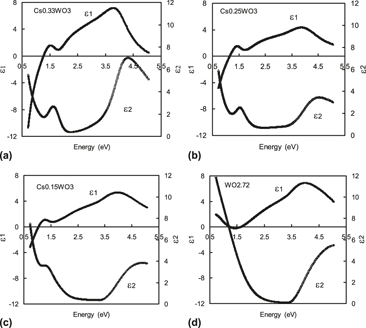Crossref Citations
This article has been cited by the following publications. This list is generated based on data provided by
Crossref.
Granqvist, C. G.
Li, S.-Y.
Pehlivan, İ. Bayrak
and
Niklasson, G. A.
2013.
Progress in Chromogenic Materials and Devices: New Data on Electrochromics and Thermochromics.
MRS Proceedings,
Vol. 1492,
Issue. ,
p.
99.
Adachi, Kenji
Ota, Yosuke
Tanaka, Hiroyuki
Okada, Mika
Oshimura, Nobumitsu
and
Tofuku, Atsushi
2013.
Chromatic instabilities in cesium-doped tungsten bronze nanoparticles.
Journal of Applied Physics,
Vol. 114,
Issue. 19,
Liu, Gaoxiang
Wang, Sinong
Nie, Yuting
Sun, Xuhui
Zhang, Yahong
and
Tang, Yi
2013.
Electrostatic-induced synthesis of tungsten bronze nanostructures with excellent photo-to-thermal conversion behavior.
Journal of Materials Chemistry A,
Vol. 1,
Issue. 35,
p.
10120.
Mattox, Tracy M.
Bergerud, Amy
Agrawal, Ankit
and
Milliron, Delia J.
2014.
Influence of Shape on the Surface Plasmon Resonance of Tungsten Bronze Nanocrystals.
Chemistry of Materials,
Vol. 26,
Issue. 5,
p.
1779.
Wang, Tingyu
Li, Yan
Li, Junping
Feng, Zhihai
Sun, Dongfeng
Zhao, Bin
Xu, Yaohui
Li, Ruixing
and
Cai, Hongnian
2014.
Synthesis and infrared shielding properties of molybdenum-containing ammonium tungsten bronzes.
RSC Adv.,
Vol. 4,
Issue. 82,
p.
43366.
Yang, Chenxi
Chen, Jian-Feng
Zeng, Xiaofei
Cheng, Daojian
and
Cao, Dapeng
2014.
Design of the Alkali-Metal-Doped WO3as a Near-Infrared Shielding Material for Smart Window.
Industrial & Engineering Chemistry Research,
Vol. 53,
Issue. 46,
p.
17981.
Mattox, Tracy M.
Agrawal, Ankit
and
Milliron, Delia J.
2015.
Low Temperature Synthesis and Surface Plasmon Resonance of Colloidal Lanthanum Hexaboride (LaB6) Nanocrystals.
Chemistry of Materials,
Vol. 27,
Issue. 19,
p.
6620.
Zeng, Xianzhe
Zhou, Yijie
Ji, Shidong
Luo, Hongjie
Yao, Heliang
Huang, Xiao
and
Jin, Ping
2015.
The preparation of a high performance near-infrared shielding CsxWO3/SiO2composite resin coating and research on its optical stability under ultraviolet illumination.
Journal of Materials Chemistry C,
Vol. 3,
Issue. 31,
p.
8050.
Choi, Jaehyuk
Moon, Kyonghwan
Kang, Insung
Kim, Sangbum
Yoo, Pil J.
Oh, Kyung Wha
and
Park, Juhyun
2015.
Preparation of quaternary tungsten bronze nanoparticles by a thermal decomposition of ammonium metatungstate with oleylamine.
Chemical Engineering Journal,
Vol. 281,
Issue. ,
p.
236.
Xin, Yunchuan
Zhou, Huaijuan
Ni, Xiaojie
Pan, Ying
Zhang, Xiaoli
Zheng, JianYun
Bao, Shanhu
and
Jin, Ping
2015.
The optical properties of low infrared transmittance WO3−x nanocrystal thin films prepared by DC magnetron sputtering under different oxygen ratios.
RSC Advances,
Vol. 5,
Issue. 71,
p.
57757.
Yang, Chenxi
Chen, Jian-Feng
Zeng, Xiaofei
Cheng, Daojian
Huang, Haifeng
and
Cao, Dapeng
2016.
Enhanced near-infrared shielding ability of (Li,K)-codoped WO3for smart windows: DFT prediction validated by experiment.
Nanotechnology,
Vol. 27,
Issue. 7,
p.
075203.
Machida, Keisuke
and
Adachi, Kenji
2016.
Ensemble Inhomogeneity of Dielectric Functions in Cs-Doped Tungsten Oxide Nanoparticles.
The Journal of Physical Chemistry C,
Vol. 120,
Issue. 30,
p.
16919.
Machida, Keisuke
Yoshio, Satoshi
Adachi, Kenji
Sato, Yohei
and
Terauchi, Masami
2017.
Modification of dielectric functions by lattice defects in lightly-absorbing LaB6 nanoparticles studied with effective medium theory.
Journal of Applied Physics,
Vol. 121,
Issue. 22,
Wang, Qingjuan
Li, Can
Xu, Wenai
Zhao, Xiaolin
Zhu, Jingxin
Jiang, Haiwei
Kang, Litao
and
Zhao, Zhe
2017.
Effects of Mo-doping on microstructure and near-infrared shielding performance of hydrothermally prepared tungsten bronzes.
Applied Surface Science,
Vol. 399,
Issue. ,
p.
41.
Xin, Yunchuan
Cao, Xun
Bao, Shanhu
Ji, Shidong
Li, Rong
Yang, Yao
Zhou, Huaijuan
and
Jin, Ping
2017.
Two-step fabrication of NaxWO3thin film via oxygen-vacancy-induced effect for energy efficient applications.
CrystEngComm,
Vol. 19,
Issue. 28,
p.
3931.
Li, Ning
Li, Yamei
Sun, Guangyao
Zhou, Yijie
Ji, Shidong
Yao, Heliang
Cao, Xun
Bao, Shanhu
and
Jin, Ping
2017.
Enhanced photochromic modulation efficiency: a novel plasmonic molybdenum oxide hybrid.
Nanoscale,
Vol. 9,
Issue. 24,
p.
8298.
Asakura, Yusuke
Anada, Yuto
Hamanaka, Ryo
Sato, Tsugio
Katsumata, Ken-ichi
Wu, Xiaoyong
and
Yin, Shu
2018.
Multifunctionality in coating films including Nb-doped TiO2 and Cs x WO3: near infrared shielding and photocatalytic properties.
Nanotechnology,
Vol. 29,
Issue. 22,
p.
224001.
Ran, Shuai
Liu, Jingxiao
Shi, Fei
Fan, Chuanyan
Chen, Bin
Zhang, Heming
Yu, Ling
and
Liu, Su-Hua
2018.
Greatly improved heat-shielding performance of KxWO3 by trace Pt doping for energy-saving window glass applications.
Solar Energy Materials and Solar Cells,
Vol. 174,
Issue. ,
p.
342.
Li, Ning
Cao, Xun
Li, Yamei
Chang, Tianci
Long, Shiwei
Zhou, Yijie
Sun, Guangyao
Ge, Lei
and
Jin, Ping
2018.
A plasmonic non-stoichiometric WO3−xhomojunction with stabilizing surface plasmonic resonance for selective photochromic modulation.
Chemical Communications,
Vol. 54,
Issue. 41,
p.
5241.
Huang, Xie-Jun
Zeng, Xiao-Fei
Wang, Jie-Xin
and
Chen, Jian-Feng
2018.
Transparent Dispersions of Monodispersed ZnO Nanoparticles with Ultrahigh Content and Stability for Polymer Nanocomposite Film with Excellent Optical Properties.
Industrial & Engineering Chemistry Research,
Vol. 57,
Issue. 12,
p.
4253.



